Monographs / Contemporary Artists
![]() Educational Dossiers - Museum’s collections
Educational Dossiers - Museum’s collections
Monographs / Contemporary Artists
|
|
|
|
| Vitrine
of Reference, 1971 |
Bio
Works
• La chambre ovale (The Oval Room), 1967
• L'Homme qui tousse (The Coughing Man), 1969
• Essai de reconstitution (Trois tiroirs) [Attempt
at Recreation (Three Drawers)], 1970-1971
• Vitrine de référence
(Vitrine of Reference), 1971
• Saynètes comiques (Comic Vignettes), 1974
• Composition théâtrale (Theatrical Composition),
1981
• Les archives de C.B. (C. Boltanski Archives), 1965-1988,
1989
• Réserve (Reserve), 1990
If the plasticine, corrugated cardboard, photographs and salvaged sundries he uses would rank him at the forefront of contemporary plastic art, he himself says he has never really moved far from the traditional paintings he made when he started out. He will also contend that dexterous hands do not define art, and that religious ends and sacred power do. So Boltanski’s work can indeed fit into pictorial traditioninasmuch as it explores the religious element in art.
The sometimes almost preposterously ordinary bits and pieces he heaps
into compendia, books and collections conceal recollections that endow them
with huge emotional power. He stages them in showcases, archives, reserves
or actual exhibitions but, in every case, makes a statement about time as well
as space. Each item, in its own different way, takes us on a journey back in
time: to Boltanski’s actual, fictional, tragic or amusing past, to the item’s
past, or to humanity’s past. The items, in that sense, relics.
All these works draw us out of the present and into a place of meditatio,
or indeed even reverence in the case of pieces in recent years probing death. Even his amusing work has something caustic about it, as if he were settling
scores with incidents from his past that still haunt him. His comic works about
individual memory, his works dealing with document conservation in mu seums
or archives are about the collective memory.
So the common denominator in Boltanski’s work is memory – spanning childhood
and personal memories, memorials and the history of humanity.
Christian Boltanski (Paris, 1944)
After a patchy education and no formal training in art, Boltanski started painting
as a teenager in 1958. His early paintings were big. They depicted historical
events or, on occasion, lonely figures in macabre settings (coffins, for one).
From 1967 he started moving away from painting and exploring other
forms of expression. He started writing letters and compiling compendia, and
sending them to prominent figures in the arts scene. His raw materials were
photocopies mingled among original documents and photographs from his family
albums. Using these new materials was tantamount to investing his personal
universe in his work. To the point where his personal history grew into
one of the central themes.
The line between his life and work indeed often blurs. But not in a romantic, self-sacrificing way: Boltanski’s works are candidly amended episodes of
his own life. Boltanski rewrites incidents from a life he has never lived, using
touched-up photographs or things he has never had. He actually wrote an official
autobiography of sorts for the retrospective that the Musée national d'art moderne
organised in 1984. His life, he wrote in those memoirs, began when his calling
became patent: “1958. He paints. He wants to make art. 1968. Doesn’t buy any
more modern-art magazines, has a shock, gets into photography, black and white,
tragic, human…”. But he did more than deride the obsequious conventions of retrospective
catalogues: he prompted readers to take a new look at the point of life from
a retrospective angle.
That is why the term “individual mythology”, the title of a section
of an exhibition he took part in back in 1972, was so fitting: he told his story
as a life anyone can identify with. Or, as he himself put it, “Good artists
don’t have lives any more: their life is reduced to telling stories that others
can believe are their own.”
Today, Boltanski is acknowledged as one of
France’s foremost artists. He lives and works in Malakoff, a suburb
southwest of Paris.
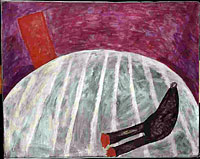
![]() La chambre ovale (The Oval Room), 1967
La chambre ovale (The Oval Room), 1967
Acrylic on isorel. 115 x 146.5 cm.
On deposit, National Contemporary Art Trust, 1983. 29348
© Adagp, Paris 2007![]()
The title is one of those puns that Duchamp loved. The paintings
that Boltanski produced between 1958 and 1967 seem to spring straight from his
childhood and until-then buried past. No doubt because they conjured
up painful memories.
La chambre ovale, one of those paintings, shows a borderline-abstract
setting enveloping a forlorn character sitting on the floor, petrified and powerless
(as we can guess from the fact that he is armless).
We can somehow identify with this character’s despondency. We don’t
know if he is a prisoner or just a child in a make-believe hell. The dark, shadowlike
silhouette is what mak es the scene mysterious.
Even though this painting probably speaks of a private incident we can't understand
because we don’t know anything about it, there is something strangely familiar
in the loneliness.
This early painting already explores some of the themes that Boltanski later
held dear. All his later works are indeed experiments further down this same
road. Or, in art critic Serge Lemoine’s words, “His work is like an extension
of his painting into other techniques. But it is still nonetheless figurative,
and still tells stories about people’s lives, childhoods, families and memories.”
(Boltanski, exhibition catalogue, Centre Pompidou, 1984, p. 18).

![]() L'Homme qui tousse (The Coughing Man), 1969
L'Homme qui tousse (The Coughing Man), 1969
3-minute-long, 16-mm colour motion film with sound.
Purchased in 1975.
AM 1975-F0023.
© Adagp, Paris 2007. Dist. Light Cone (circ. Rmn).![]()
Boltanski’s first-ever personal exhibition already spoke of cinema’s pull over him. He organised that exhibition in a projection room in Paris’ 16th arrondissement, screening a film called La vie impossible de Christian Boltanski (The Impossible Life of Christian Boltanski) (1) amid life-size puppets.
After that first attempt, be produced a string of short fantasy films
in 1969. L'Homme qui Tousse was one of them.
This three-minute-long film features a man sitting in a tiny dingy room, almost
literally coughing his lungs out and literally spewing up a gush of blood
all over his clothes and down his legs. The rudimentary equipment Boltanski
used to shoot this film gives it some of its documentary feel and disturbing
effect.
He then gradually moved away from films and towards photography. But the underlying urge to explore the ambivalence between truth (the documentary element) and untruth (the fact that it is a show) remained intact.
- (1) Boltanski revisited this theme recently in a new piece, La Vie impossible (2001), a string of twenty showcases displaying photographs, journals and letters touching on his life as an artist, which this Museum acquired in 2004
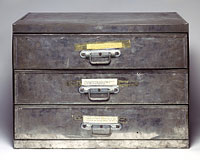
![]() Essai de reconstitution (Trois tiroirs)
Essai de reconstitution (Trois tiroirs)
Attempt at Recreation (Three Drawers)], 1970-1971
Formerly Trois Tiroirs (Three Drawers).
A tin-plate chest containing three drawers held shut with wire netting, each
sporting a label and containing various objects.![]()
This three-drawer tin-plate chest epitomises Boltanski’s early ventures
into the theme of lost child hood.
He wrote his first book, “Recherche et présentation de tout ce qui reste
de mon enfance, 1944-1950” (Investigation
and presen tation of all that is left of my childhood, 1944-1950) (1) in 1969.
He originally only published 50 copies of this book which was, in a way, an
attempt to recreat e a period of his childhood and present the result as a work
of art. Its nine p ages contain a school photo and essay, and keepsakes that
remind us of the bits and pieces we might have stored away caringly in cardboard
boxes.
Trois tiroirs is a similar – but more three-dimensional recreation. The drawers contain plasticine objects replicating things which, as the typed labels on each drawer tell us, Boltanski probably had as a child (planes, a hot-water bottle and so on). They are his way of reminding us of those inconsequential treasures we prized and cherished as children.
This recreation also captures something of the earnest seriousness that childhood games somehow involve, making it both funny and endearing.
It also foreshadows a series of archive works that Boltanski produced in the 1980s (2). Those, again, feature the same tin-plate chests full of unpretentious, commercially worthless objects encapsulating an undeniably huge wealth of private emotion-steeped memories.
- (1) See reference text below
- (2) See Les archives de C.B. 1965-1988 below

![]() Vitrine de référence (Vitrine of Reference), 1971
Vitrine de référence (Vitrine of Reference), 1971
A painted wooden box under Plexiglas, containing photos, hair, fragments of the artist’s clothes, a sample of his handwriting, a page of his reading book, 14 earth balls in a pile, a trap consisting of three objects made of pieces of cloth, wire, pins. Wood, Plexiglas, photos, hair, fabric, paper, earth, wire. 59.6 x 120 x 12.4 cm. ![]()
This piece takes us a step further down Boltanski’s ventures into his own life and past. He made several of these showcases to display personal belongings staging them as relics or as archaeological vestiges of lost civilisations.
They are also his way of caricaturing the Musée de l'Homme, the anthropological museum in Paris. Boltanski himself explains what had struck him there. The artefacts lying under dusty glass windows had been manufactured with no aesthetic purpose to start with. Now that the museum had also sapped the value they once had as practical implements, they had become something more akin to documents than to works. He went on to describe muse ums as “devoid of reality, worlds unto themselves, protected, where everything is supposed to look nice.” Museums, in other words, are in a time warp of their own. They are not real. Or unreal. And they convey that bizarre status to the relics they contain.
So presenting some of his own personal belongings in a museum-like showcase was Boltanski’s way of keeping his own relics. And of mummifying them.
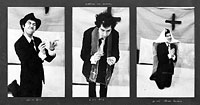
![]() Saynètes comiques (Comic Vignettes), 1974
Saynètes comiques (Comic Vignettes), 1974
Le mariage des parents (Parents’ wedding)
Photograph. Three silver proofs, assembled alongside text written with white
ink on blue cardboard.
37.9 x 71 cm. Each photo measures 28.5 x 18.3 cm.![]()
1974 saw Boltanski’s autobiography-exploring endeavours take a lighter
turn. Or, as he put it in his memoirs, “he outdid himself, he surpassed himself,
he took a step back and started making fun of himself. He stopped talking about
his childhood a nd started playing with it” that year.
He actually seems to shy away from the solemnity that shrouded his
previous endeavours. Until then, he had been trying to tell the story of Christian
Boltanski the character. But then he got to a point where, in his words, “That
make-believe character became too heavy, and I felt the urge to kill it (…)
kill the myth (…) kill it in ridicule.” (Boltanski, in an interview with Delphine
Renard published in the Centre Pompidou catalogue in 1984).
Hence the Saynètes Comiques, a series of 25 pieces containing photographs
he had touched up using pencils or pastels. Again, they recount his life, but
they do it farcically this time.
Each photograph or group of mounted snapshots shows a family milestone (a funeral, wedding or birthday), which he had re-enacted for the camera. So all the characters are actually Boltanski disguised in a few accessories. That gives these images an unpretentious, almost scruffy look and street-theatre atmosphere that ultimately elicits contempt. The backdrops are often drawn in, adding to the spaghetti-western feel, and some of the labels explaining the scenes exacerbate the grotesque ingredient.
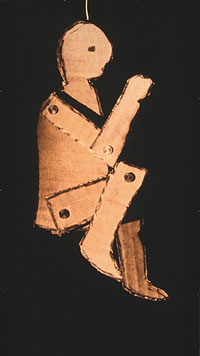
![]() Composition théâtrale (Theatrical Composition), 1981
Composition théâtrale (Theatrical Composition), 1981
Cibachrome in a black showcase frame. 241 x 124.5 x 8.8 cm.
Detail of a triptych: 241 x 373.5 cm.![]()
Boltanski was using photography extensively in the late 1960s. At first,
he took small black-and-white phot os from family albums or photos that otherwise
had some documentary value, and displayed them alongside text or other items.
Then he started using this technique in a completely different way in the mid
1970s. He started showing large colour photos with no accompanying text or items
(thus carrying the message single-handedly). He created a series he called Compositions.
Depending on the object they portrayed, they were heroic, grotesque, architectural, Japanese or enchanted. The photographs
were invariably huge and the backgrounds invariably jet black, making the tiny
objects they depicted look monumental. There is something in their overblown
size and colour contrast that makes them look like a vision. The black background
makes the figures stand out like shadow puppets in the light. It also nestles
them in an unfathomable void, isolating them in a sort of endless realm.
His 1981 Compositions Théâtrales feature diminutive corrugated-cardboard
puppets that he had made for the occasion with wire and paper fasteners. These
clever little makeshift characters are unmistakably reminiscent of the corrugated-cardboard
objects that Picasso used in the 19 10s, with the difference that Boltanski
made these toys for himself. They belong to Boltanski’s private, nearest-and-dearest
treasure chest. He speaks of them as voodoo fetishes, explaining that they are
made of tatty scraps yet harbour enormous evocative power. The public only sees
them in the photographs that make them look huge and beyond reach. Boltanski,
incidentally, spoke of photography as the “cooling off’ or separation
stage. And, in a 1984 interview, explained that “objects are in the intimate,
touchable realm: photographs in the realm of representation” (Boltanski,
exhibition catalogue, Centre Pompidou). Photographs, in other words, have a
way of transfiguring manual work.
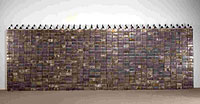
![]() Les archives de C.B. (C. Boltanski Archives), 1965-1988, 1989
Les archives de C.B. (C. Boltanski Archives), 1965-1988, 1989
Installation with light.
Metal, photographs, lamps, electric wire. 270 x 693 x 35.5 cm.![]()
Les archives de C.B. 1965-1988 shows Boltanski back in touch with the high call he had defined thus in 1969: “To keep traces of every insta nt of our life, of all the objects that have come into contact with us, of everything we have said and everything that has been said around us: that is my goal”.
For this project, he built a wall using 646 tinplate biscuit tins,
covered in varying degrees of rust, mirroring passing time’s corroding force.
He had used tins like these back in 1970, when he was working on his Trois
Tiroirs, for example, to house plasticine replicas of toys from his childhood
(1).
But Les archives de C.B. 1965-1988 is on a different scale altogether. The
646 tins are stacked nearly three metres high, lit by black desktop lamps and
amid dangling electric wires. The impression is that the whole piece was erected
in a rush. The implication is that this is a makeshift archive, thrown together
to rescue things otherwise doomed to oblivion.
These tins contain more than 1,200 photos and 800 documents that Boltanski gathered
when he cleared his atelier. These tins, in other words, contain records from his entire life as an artist, shielded from view. They are only present in
his memory and privacy.
Boltanski ventured back to this personal-archive theme in 2001 with La Vie impossible
(The Impossible Life), a string of 20 display cases crammed with all sorts of
papers. Again, if this time he did not hide his keepsakes from sight, he stashed
them in such a mess that their mystery remains unfathomed .
(1) See above.
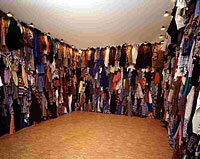
![]() Réserve (Reserve), 1990
Réserve (Reserve), 1990
Installation.
Fabric, lamps. Variable dimensions.
Purchased in 2000.![]()
Boltanski started using a new raw material, clothes, in 1988. They first appeared in a poignant piece, Réserve, Canada. This work echoes the warehouses that Nazis used to store the belongings of the deported. Boltanski, in other words, associated clothes with death from the outset (as he had with photography). In his words, “Someone’s photograph, garment or dead body are pretty much the same thing: there was someone there, now they’re gone.” Garments are also vestiges or marks that bear testimony to a life now past.
That is what clothes meant in the string of Réserves that followed. They are all installations that play on the subject of death and memory. In his 1989 Réserve: la Fête de Pourim (Purim Holiday) and 1990 Réserve: Lac des morts (Lake of the Dead), the clothes lay on the floor. In his 1989 Réserve du Musée des enfants (Children’s Museum), he stacked them in rows (1).
For his 1990 Réserve, he lined the walls of a whole room in loft-smelling
hand-me-down clothes. Because this work’s overbearing presence is not just
visual: it is also olfactory – a dimension that plastic art does not
use enough (2).
Much like the other works in this series, the atmosphere that the 1990 Réserve
creates is a door to melancholic contemplation of the body as a brittle vessel,
vanity and death (all of which ranked among Boltanski’s favourite themes in
the 1990s).
- (1) This work can be seen at the Dernières Années (Last
Years) exhibit ion at the City of Paris Museum of Modern Art ![]()
- (2) One of the works in the collections of the Musée national d'art moderne
that best explored this dimension before Boltanski’s Réserve is Beuys’ Plight, 1985 (see the Online collection, Numéro d'inventaire : AM 1989-545).
timeline
1958
Boltanski’s first paintings. They were figurative in style. He switched
from painting to more experiment al media in 1967.
1966
Met Jean Le Gac. They teamed up in 1969 and worked together for a few years
after that.
1968
Staged his first personal exhibition, in the Théâtre du Ranelagh ( Paris),
featuring life-size but deliber ately rudimentary puppets and a film that arguably
condensed what his early work was all about: La Vie Impossible de Christian Boltanski.
1969
Published his first book, Recherche et présentation de tout ce qui reste
de mon enfance, 1944-1950, heralding the autobiographical element in his work
.
1970
Started working on his Vitrines de Référence series. This project stretched
into 1973.
1972
First exhibition in Documenta 5, Kassel (), in the “Individual Mythologies” section.
1975
After one last light-hearted d ig at his autobiography in his 1974 Saynètes
Comiques series, he chucked his own character and moved on to explore cultural
codes and clichés (ad portraits or honeymoons in Venice, for instance). He used
colour photographs – blowing them up to increasingly overbearing dimensions
– to do so.
1977
Started working on his Compositions, with huge painting-size photographs.
1984
Retrospective at the Musée national d'art moderne. An opportunity for him
to experiment with a new way of displaying his work. This exhibition was split
into two sections: one was autobiographical (showcasing his documents and archives)
and the other photographic (with large photographs more akin to classic pictorial
works).
1985
Started working on the Monuments series. The subjects, here, were photographs
of nameless faces on walls in altar-like constructions or constellations lit
by small lamps.
1986
Was invited to the Venice Biennale and took over an area in an old prison,
Palazzo delle Prigione, to house his exhibition in half light (which became
a constant feature in subsequent exhibitions).
1987
Broached the Holocaust for Documenta 8
in Kassel. He had done so before, but never so bluntly.
1988
Clothes appear in his work.
1990
Started his Les Suisses morts (The Dead Swiss) series, using photographs
from a Swiss newspaper’s obituaries. He chose the Swiss because, in his words,
they “have no reason – or at least historical reason – to die”. This work shows
Boltanski’s thoughts turning to the brutality of death in general.
1998
Dernières Années exhibition at the City of Paris Museum of Modern Art. This
show was designed as a single walk-through piece. It features the issues Boltanski
has been broaching of late (how presence and absence intermingle in memory,
in particular).
2003
Entre-temps (Meanwhile) exhibition at the Yvon Lambert Gallery in Paris.
Boltanski picks up the autobiographical theme again.
2004
The Museum of Jewish Art and History ran a year-long exhibition for his Théâtre
d'ombres (Shadow Play).
REFERENCES / BIBLIOGRAPHY ![]()
For references and bibliography : you can consult the French version of the file Boltanski.
To consult the other dossiers on the collections of the National Museum of Modern Art
In French
![]()
In English
![]()
Contacts
So that we can provide a service that meets with your requirements, we would like to have your reactions and suggestions regarding this document.
Contact: centre.ressources@centrepompidou.fr
Text : Vanessa Morisset
Layout : Michel Fernandez / Ariane Cock-Vassiliou
Translated by Vice Versa
Copyreader : Olivier Rosenthal
Dossier on-line at www.centrepompidou.fr/education/ section on ‘Educational
Dossiers’
Co-ordination: Marie-José Rodriguez